 |
  |
 |
  |
Connecting to Ramlila through its rituals - Sunil Sunkara e-mail: sunilrsunkara@gmail.com December 6, 2021 Abstract - The Ramlila has resonated with the Indian heartland and continues to do so till date. This essay looks at the Ramlila from the perspective of the audience who are a combination of observers, devotees and satsangees. In specific, the essay looks at the rituals within the staging of the Lila, that make the Lila experience a unique intersection of the sacred and the mundane. Introduction When perceived from a western viewpoint, the word ritual resonates with solemnity of action, religious symbolism and conformation of tradition. The Indian perspective is to look at any concept through a distilled viewpoint (darshana). Abhinavagupta mentions that it is not liberation that is the ultimate goal of mankind but the aesthetic relish of liberation (moksha).The objective of lilanukaran tradition is an enjoyment of that relish or Rasa and then absorbing the fruit of that experience into the daily cycle of mundane life. 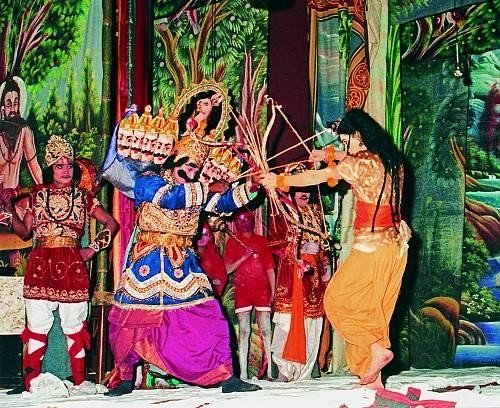 Ramlila - Ram giving Moksha to Ravan © Sangeet Natak Akademi, New Delhi Ramlila, literally "Rama's play", is a performance of the Ramayana epic in a series of scenes that include song, narration, recital and dialogue based largely upon the Tulsidas Ramcharitmanas. It is performed across India during the festival of Dussehra, held each year according to the ritual calendar in autumn. The most representative Ramlilas are those of Ayodhya, Ramnagar and Benares, Vrindavan, Almora, Sattna and Madhubani. Resonance of Ramlila with day-to-day rituals In his1908 text 'Rites of Passage', French anthropologist Arnold van Gennep proffered that all the significant milestones in a person's life that involve the community - birth, puberty, marriage and death share a common structure composed of three phases- I. Separation II. Transition III. Incorporation If we look at the physical time (kala) of the staging of the lila as one lifetime, we can find these three stages within the Ramlila. Here the Ramlila of Ramnagar, Varanasi has been considered as a case study. I Separation To attend the Ramlila at Varanasi, devotees cross the Ganga to go to the lila ground for the evening performance. The river symbolically represents the separation between the sacred and profane space, and crossing it the devotees and audience alike experience a physical transition that pulls them away from the social structure of work and family life and joins them with others who are about to share a common spiritual experience (becoming sahhridayi) 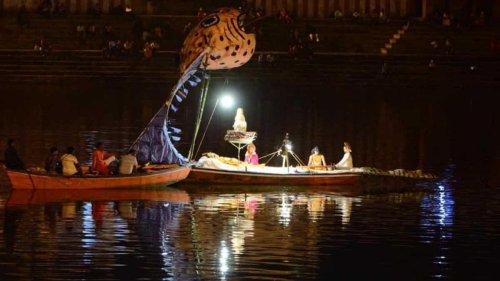 Crossing the Ganga during Ramlila This idea of separation trickles into modern day staging also. Though the staging at Varanasi offers the crossing of the Ganga as a deeper experience, simple welcoming acts like application of chandan to the forehead of the audience as they enter, or the removal of shoes before entering the performance space and taking seat within the baithak, are equally effective in separating the scared space of lila and profane or mundane space of daily life. II. Transition This is the time spent in the physical space or the lila ground before or after a performance. Often, one hears comments about how in the time period (e.g. one month) of attending daily lila performances, the very ground seems to have become an abode of the Gods. The ground area is also the area where morning and evening pujas would be done as well as a daily reading of the Tulsidas Ramcharitmanas. The subconscious awareness of these tangible aspects creates an intangible transition within the observer into the sacred space. Thus while the previous stage of separation acts upon the Sthoola Shahira, the transition acts upon the Sukshma Shahira. 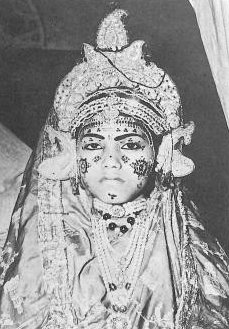 Sita in Ramnagar Ramlila कहव ठाई प्रसीसिय चाईहिं दयवरहिं रामायणु अहिणवियई कत्थहि कयवरहिं Sandesha rasask II.44 (At some places Brahmins who have renounced the world bless the people and in others the great poets (Kavivarihya) are enacting the Ramayana) III Incorporation This is the crux of spiritual communication and looks at how the effects of attending the lila are incorporated into the lives of the audience. This is where rituals done at home such as daily puja to Lord Ram in the household temples or reading of Ramcharitmanas at home intensifies the experience. The Ramayan is an itihasa that gives life lessons on the four purusharthas of Artha, Kaama, Dharma and Moksha. The rasa experience leaves an imprint on the Kaarana sharira or inner self through an incorporation of 'bhava' into the psyche. पहिलो तिलक रामलीलावर । जिहि लखि परति न तिमिर कूप नर ॥ जाको जहाँ अर्थ है जैसो । लीला ललित लखावहि तैसो ॥ The great Ramlila is the primary commentary and seeing it helps man to avoid a fall in the dark chambers of hell; all the concepts and utterances of the Ramcharitmanas are elaborated and become clear in the Ramlila. The jhanki (tableau), followed by puja (offering of gratitude) is another instance of incorporation where the audience gets a chance to participate directly in offering to the divine medium through the actors. One often sees the yajaman or the sponsor of the lila, or sometimes the chief guest offering the arati on behalf of the audience. 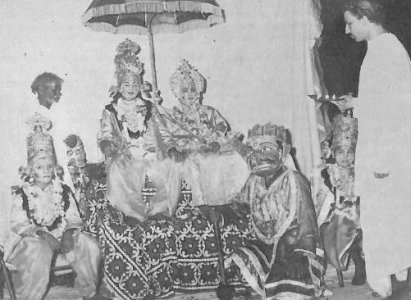 Yajaman at Ramnagar Ramlila 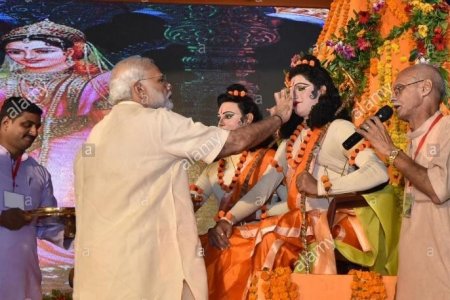 Prime Minister Modi at Ramlila The audience directly participates in the Ramlila through the Yatraa events. Three 'savaris' or 'yaatras' (processions) are taken out during this Ramlila - first, on the opening day, to invite Lord Ganesh to visit the lila, the second is held on the fourth day, i.e., Ashtami, of Lord Ramachandra's baraat (marriage procession), and the third one on the sixth day, i.e., Dashami, when Ravan's effigy is burnt (although Ravan is killed only on the last day of the Ramlila). Only one effigy of Ravan is burnt, and the lila continues from the next day as usual. Interestingly, around fifty years back, no tradition of effigy burning was seen. Instead, Ravan was made with the help of around a dozen water-filled pitchers, which were destroyed by Lord Ram and all the villagers also with bamboo sticks. This is an example of how the involvement of the audience in the ritual led to an evolution of the ritual (innovation within tradition).  Baraat of Lord Ram Conclusion In summary we can look at lila and ritual from three intersecting views from the point of view of the audience connecting to the lila. Lila as a Ritual - The permanency of the annual tradition of Ramlila reflects how staging the lila is an important ritual. Ritual in Lila - The various rituals lead the observer/participator to reach the Rasa experience. The Lila in Ritual - The rituals themselves are a divine play for the common man to find divinity within themselves, making the mundane sacred. References Books and Articles: Indu Awasthy, 'Ramlila: Tradition and Styles', Online Archive National Centre for Performing Arts, Mumbai Pierre Bonnechere, Sarah Bonnemaison, Claude Calame, 'Sacred Garden sand Landscapes: Ritual and Agency' Dumbarton Oaks (2007) Richard Schechner and Linda Hess,'The Ramlila of Ramnagar', The Drama Review: TDR Vol.21, No.3, Annual Performance Issue(1977) Sarah Bonnemaison,'Sacred Texts and Ritual Spaces in the Ramlila of Ramnagar', Harvard University Press (2007) Vishveshwer Dayal Kushal.'Ramlila Natak Kushal', Dehati Pustak Bhandaar (2018) Hyperlinks: thehindu.com ich.unesco.org  A chemical engineer who has pursued his doctorate in biofuel research, Sunil Sunkara holds a masters degree in Kathak from Bharata College of Fine Arts and Culture, Mumbai, and Nritya Nipun from Bhatkhande Sangit Vidyapith, Lucknow. He performs regularly as well as pursues research in Kathak apart from curating dance events and regularly writing on various facets of dance through both print and online medium. Post your comments Pl provide your name and email id along with your comment. All appropriate comments posted with name and email id in the blog will be featured in the site. |